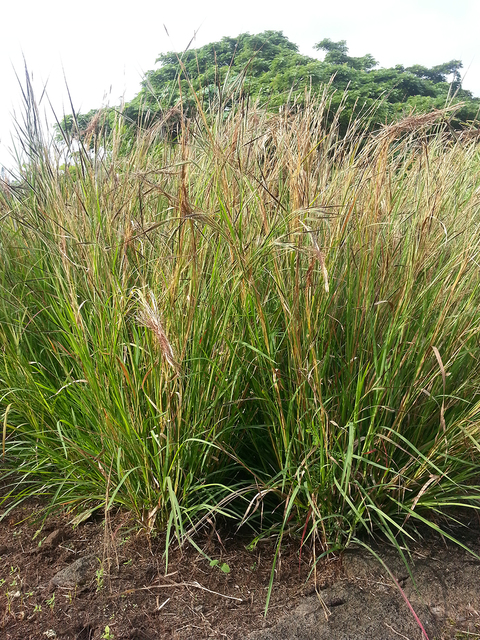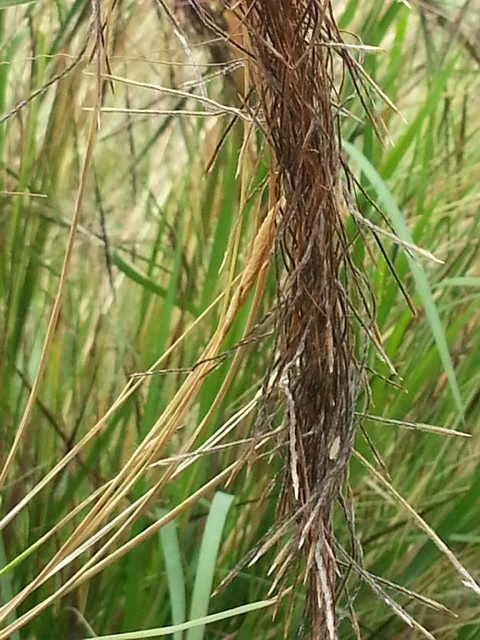Dedicated growers bringing back pili grass
Hawaiian pili grass is having a revival thanks to some dedicated growers. This clumping grass in the Poaceae (grass) family is an interesting and attractive addition to a landscape, as a pre-planted mulch or in grazing pastures. Native Hawaiians had several cultural uses for pili as well. It once grew abundantly in open spaces on all the islands but has been crowded out over the years by invasive grasses including fountain grass. In landscapes where clumping grasses are called for, pili is an excellent choice.
Pili (Heteropogon contortus) is one of 80 grass species that are native to Hawaii. Most of them are endemic, though pili is probably indigenous since it is native in many other tropical locations as well. It is also possible that pili grass was brought to Hawaii by early Polynesian settlers. Today it is widely naturalized in tropical and subtropical regions of the Americas, East Asia and throughout the Pacific. It is sometimes known here by the English name tanglehead referring to the tendency of the mature seed heads to bunch up or tangle.
Pili’s genus name Heteropogon is derived from the Greek word heteros, meaning different, and pogon, which means beard. This name refers to the growth pattern of the seed heads. The Latin word contortus refers to the pili seeds’ unusual habit of contorting when wet in order to burrow into the soil. In Hawaiian the name pili means “to cling or stick,” again referring to the shaft whose corkscrew shape can burrow into soil as well as fur, feathers and clothing.
Pili grass is an herbaceous, tropical, bunching or tussock grass that is a perennial here in Hawaii. Mature clumps of erect pili are usually 2 feet or more high and have a 2 to 5 foot spread. A more prostrate variety usually stays low at 12 inches or less. The leaves of both types are coarse and tough and produce small insignificant brownish or white blooms throughout the year. These inflorescences develop into the dark brown seed heads of pili grass. The individual seeds have sharp spikes that help them burrow into the soil where they land. In dry conditions the spikes have a corkscrew-like twist. In moist conditions they straighten and are capable of drilling the seed into the soil to germinate. The erect type of pili grass reseeds itself prolifically but the prostrate type needs to be propagated by root division.
Pili is somewhat similar to fountain grass in that fire is a useful tool in managing large stands of the grass. Unlike fountain grass, pili seed germination is not encouraged by fire, but burning is used to create open space for the seedlings to establish themselves.
Growing pili from seed in cultivation requires patience as two dormancy periods can stall germination for up to 12 months. Though the plants reproduce from seed well in the wild, gardeners may prefer to take root divisions from existing plants to acquire new clumps. Taking divisions for new plants annually is a good idea as the life span for a pili grass clump is about 5 years.
Pili grass is a hearty ground cover that grows best in full to partial sun in soil that drains well. Spacing the clumps closer than 2 feet will encourage tall growth. Pili grass is drought tolerant, and can tolerate wind, salt spray and high heat. It can survive with very little water or fertilizer and needs almost no care or attention. Annual pruning can be done to encourage new growth. Pili is occasionally subject to attacks by scale, mealy bugs, aphids and thrips but is generally pest free.
Early Hawaiians developed several uses for pili grass, which was once plentiful on all of the Hawaiian Islands. It was the primary grass used to thatch roofs for its brown color, neat appearance and pleasant odor. The thatching was replaced every four or five years. Bunches were harvested and trimmed then tied close together with ukiuki grass in rows with stems up starting at the bottom of the frame and working upwards. The grass also lent itself to use for flooring, in mattresses and other padding. The English name “grass shack” probably referred to the grass-covered structures that colonists found here.
Other uses were common when the grass was more plentiful. Early Hawaiians used the ash from burned pili grass for dyeing tapa cloth and as an ingredient in some medicinal remedies.
The attractive and hardy stands of pili grass here in Hawaii served as models for its use in restoring the Great Plains’ grasslands and prairies in parts of the US mainland with growing conditions that suited pili. It has also been used in conservation efforts here in the islands, especially in replanting efforts on Kahoolawe and as a roadside grass to displace invasive species like fountain grass.
Pili grass is a terrific accent plant, especially in native Hawaiian gardens. It can also serve as a hedge or simply as a ground cover to control erosion. Though basically a xeric grass, pili is usually greener and more attractive when it receives regular watering and occasional nitrogen fertilizing.
Pili grass has been grown at the Hoolehua Plant Materials Center on the island of Molokai for NRCS reforestation projects. Plants may be available through them. The State Tree Nursery in Waimea and Amy Greenwell Garden in Captain Cook often have plants for sale as well. Local grower Angelica Stevens is currently cultivating pili grass and selling seed. Her intention is to use it as a ground cover on her own farm and encourage other farmers and gardeners to use it for weed control as well as for soil and water conservation. She can be contacted for information on the use of pili in garden and farm settings at homeokahaluu@gmail.com.
If you are looking for clumping specimen plants, grassy edging or row dividers or simply want to use and work with native Hawaiian plants, pili grass should be added to your plant list.
Diana Duff is a local organic farmer as well as a plant advisor and consultant.




